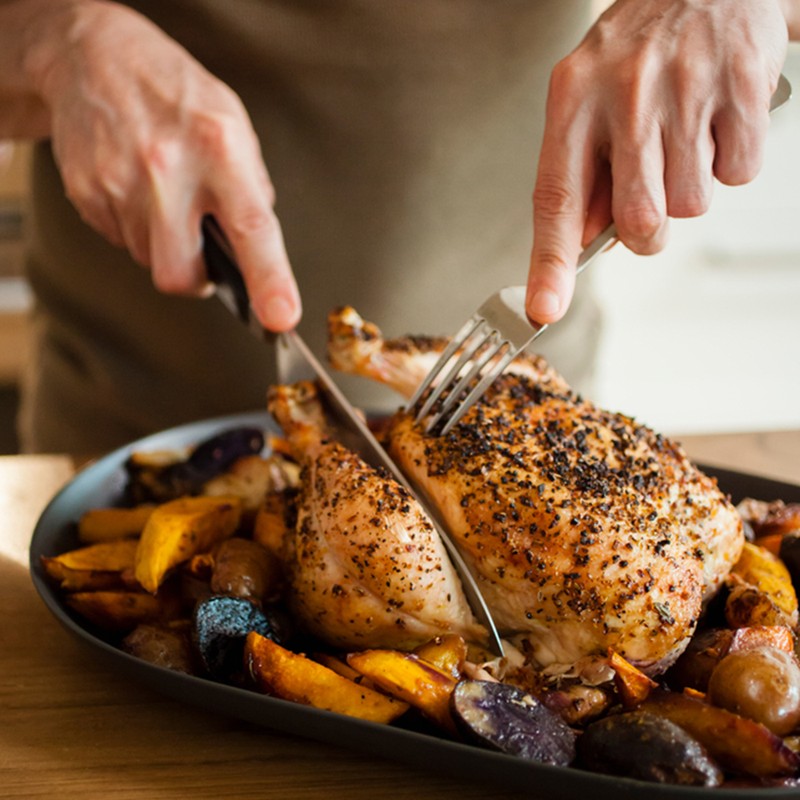Carving Tips From The Experts
1. GET The Right Equipment
“Carving equipment is the same for nearly all joints and cuts of meat. The essentials are: a digital thermometer to monitor the ‘cuisson’ (cooking time) when you cook and rest the meats/joints; a large chopping board to allow yourself plenty of space to work efficiently; kitchen roll to keep the chopping board dry and knives clean as you work (this is really important!); a suitably sized and sharp knife; tongs or meat tweezers to arrange the sliced meat.” – Matt
2. Rest Your Meat
“This is a given. You have to allow a certain resting time for your meat. After it’s been cooked, remove your meat from the oven and place on a wire cooling rack, then loosely cover with tin foil. This allows the meat to rest. By the time you carve your joints or bird, the juices will have settled in and been reabsorbed by the meat, resulting in a juicy and flavorful cut. At Roast, for beef rump, we cook at 180ºC until the meat is at 30ºC (check with your thermometer!) then let it rest for 45 minutes; for lamb shoulder, de-bone, roll and cook it for 3.5 hours at 80ºC. We’d then blast-chill it and sear in a hot pan, before letting it rest for 25 minutes. Chicken we cook at 210ºC for 15 minutes, then 170ºC for another 25 minutes. Then we rest it for 15-20 minutes – be sure to collect all the juices for your gravy.” – Matt
“We roast a centre-cut pork loin – skin-side up for the best crackling results – at 220ºc for 20 mins and turn down the oven for a further 15 minutes at 160ºc. Then it needs 15 minutes of rest before carving.” – Oliver
3. Carve At The Table
“Plate up your sides and ready the serving plates. Carving the meat should be the last step before presenting to your guests. It’s best to do the carving at the table, so you involve the guests and bring them closer to what they’re eating.” – Oliver
4. Use A Carving Knife – Not A Chef’s Knife
“A carving knife is elegant, refined and ready for one purpose. Its long slender blade allows it to slice through different meats cleanly and effortlessly. Don’t push down when carving; instead, use a little pressure and let the knife do the work for you.” – Matt
“A carving knife is designed so that you can action a carving motion (forwards and backwards) without pulling or tearing the flesh, making a clean cut.” – Oliver
5. sharpen Your Knife
“If your knife is really blunt, use a wet stone. If it needs refreshing, use a diamond steel sharpener. If you use diamond steel at end of every carving session, you should keep the edge.” – Oliver
“Using a sharp knife will make carving so much easier and more enjoyable!” – Matt
6. go Against The Grain
“When you’re carving a joint, it’s very important to look at the meat and work out which direction the grain is running. You need to slice against the grain. This will make the end result more tender, as you shorten the natural fibers and make it less chewy. With a chicken or any bird, look to start carving from the top of the backbone. Angle your knife to achieve the largest and longest slices possible.” – Matt
“If it’s a bird, you leave the bone or spine on the roasting joint in the oven. This helps to retain the juices in the meat and ensure a succulent cut. If you are carving a joint, use a carving knife to take off the backbone of the joint, so that it’s boneless for serving. You then carve across the grain for perfectly cut slices.” – Oliver
7. Carve Off A Little Extra
“As a general rule of thumb, allow 200g to 300g of protein per serving. That’s usually enough but, at home, I always count for three extra people, so that there is always enough for seconds – or to make delicious leftover sandwiches the next day.” – Matt
Matt Bishop is head chef of Roast in Borough Market.
Oliver Gladwin is chef director of Sussex in Soho.
DISCLAIMER: We endeavour to always credit the correct original source of every image we use. If you think a credit may be incorrect, please contact us at [email protected].


